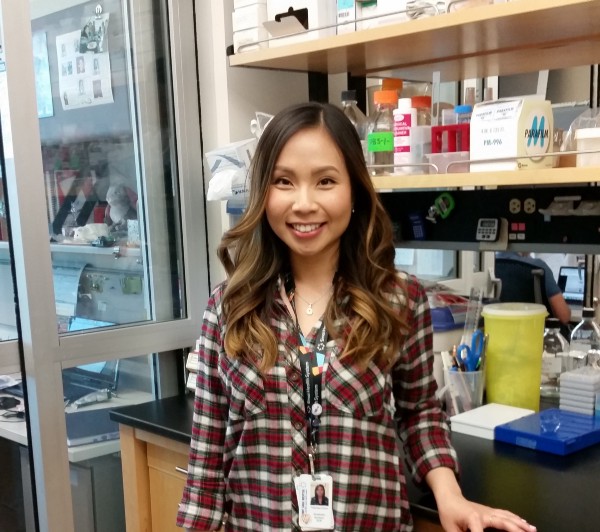Scraped knees, kidney organoids and uniting two passions
By Meredith Hanel
 Fourth year Ph.D. student Theresa Chow is talking stem cells with a challenging audience — but poses a question they will relate to:
Fourth year Ph.D. student Theresa Chow is talking stem cells with a challenging audience — but poses a question they will relate to:
“Say you fall on the ground, and you scratch your knee, and in a week that scab is gone. What helps that scratch go away?”
The average 7-year-old doesn’t know that stem cells are responsible for repairing the skin, but it’s a concept Chow hopes to get across along with the idea that they can aspire to be scientists. In the realm of regenerative medicine Chow pursues both her passions: research and public outreach.
Chow works with skin cells in Dr. Ian Rogers’ lab at Lunenfeld-Tanenbaum Research Institute, but she isn’t trying to fix scraped knees. Her research aims to repair diseased kidneys. The first step is reprogramming cells that come from skin and other easily accessible sources like urine and blood, by first signalling them to turn into a type of stem cell called induced pluripotent stem cells (iPS cells). She then directs them to become kidney progenitors, cells that are about half way between a stem cell and a kidney cell, but still have the ability to make all the different specialized cell types in the kidney.
These kidney progenitors could be used in cell therapy or coaxed to form kidney organoids, three-dimensionally organized kidney structures useful for drug testing. Chow says, “I think the ultimate goal for any regenerative lab would be to rebuild a whole organ for transplant,” but stresses that this is a long way off.
The Rogers lab prepares natural mouse kidney scaffolds for the kidney progenitor cells to grow on by taking the organ and washing the native cells off with a mild detergent. This leaves behind a sort of tissue skeleton called the extracellular matrix (ECM). Recently they have been trying this with pig kidneys, through collaboration with OIRM researcher Dr. Markus Selzner. “The idea is that I would make these progenitor cells in the dish and put them back on the ECM scaffold and hopefully rebuild the nephrons and different kidney structures to get a functional kidney in the end,” explains Chow.
Within two years Chow hopes to complete her Ph.D., adding with a laugh, “I think that’s my limit.” In between successes, there are long hours and dry spells that can tire graduate students but Chow’s outreach work with the yearly Let’s Talk Science event, StemCellTalks, reinvigorates her in her own research. “When I do StemCellTalks with all these grade 11–12 students, I think it’s so refreshing, the enthusiasm they have for stem cell research, and it actually gets me excited about my own work as well.” Chow has co-headed the event with fellow University of Toronto graduate student Nika Shakiba for three years and also participated with Super Cells, a travelling science exhibit for children that visited the MaRS discovery district last November.
“When I was a kid I didn’t know what research was,” recalls Chow. “On TV no one talks about scientists and researchers, it’s all about doctors and nurses.”
As a result, this career possibility first went unnoticed by Chow, who instead flocked towards medical school with many of her University of Toronto undergraduate peers. But hospital volunteering showed her that medicine just wasn’t her thing. She soon found that research was, saying of her fourth-year thesis research in plant-microbe interactions with Dr. John Stinchcombe, “I found it challenging but then it was also very satisfying at the same time. That’s when I realized research was my passion.”
What attracted her to this lab was Dr. Rogers’ enthusiasm and optimism. After completing a Masters in the Rogers lab working on a mouse model for bone marrow graft rejection, Chow says she wanted to change her project, but stay with the labmates she loves working with and the healthy work environment she finds at The Lunenfeld-Tanenbaum Research Institute.
After finishing her Ph.D. Chow wants to translate basic stem cell research “from bench to bedside” and keep feeding her other passion for public outreach. She thinks more researchers should talk to the public to avoid misconceptions that might hinder public support for stem cell research, and being a role model is important too.
“If having these outreach programs for kids tell them that, ‘Hey there’s more than just being a doctor if you’re interested in science,’ I think that’s very important.”
**Photo courtesy of Theresa Chow
